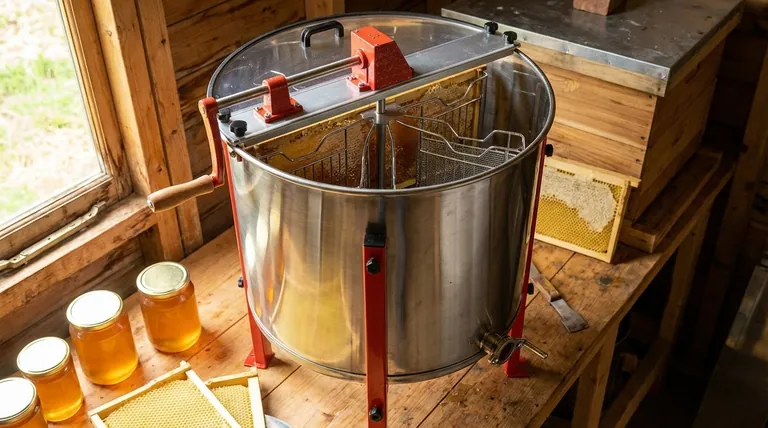A tangential honey extractor is a mechanical device that uses centrifugal force to pull honey from the honeycomb, but it is defined by its method of extracting from only one side of a frame at a time. This design requires the beekeeper to manually stop the machine, flip each frame over, and then repeat the spinning process to extract honey from the second side. This makes it a more hands-on, multi-step process compared to other designs.
The core principle of a tangential extractor is its trade-off between speed and gentleness. While it is slower and more labor-intensive, its design provides excellent support for the honeycomb, making it an ideal choice for beginners, small-scale operations, or those working with fragile combs.

The Mechanics of Tangential Extraction
To understand if a tangential extractor is right for you, it's essential to grasp how its design directly impacts the extraction process.
Frame Orientation and Support
In a tangential extractor, frames are placed inside the basket with one side of the comb facing outward, resting against a mesh screen. This screen provides full support across the face of the comb.
The Two-Step Process
When the extractor spins, centrifugal force flings the honey from the outward-facing side of the comb against the inner wall of the drum. Once this side is empty, the process is stopped, the frames are manually turned around, and the process is repeated for the other side.
Why This Method Is Gentler
The mesh screen supporting the comb is the key to its gentle action. Because the entire comb is braced, there is less risk of it "blowing out" or being damaged by the force of extraction, which can be a concern with heavy, freshly-filled, or older, more brittle combs.
Key Features and Primary Users
The design of a tangential extractor lends itself to a specific set of features and is best suited for a particular type of beekeeper.
Suitability for Small Apiaries
Tangential extractors typically have a smaller capacity, holding between 2 and 9 frames. This makes them perfectly suited for hobbyist beekeepers with a handful of hives, as the batch size aligns with a small-scale harvest.
Cost-Effectiveness
Due to their simpler mechanics and smaller size, tangential extractors are often the most affordable option on the market. This low barrier to entry makes them a popular choice for those just starting in beekeeping.
Manual and Electric Options
While many are simple hand-crank models, electric versions are also available. An electric motor removes the physical effort of spinning but does not change the fundamental need to stop and flip the frames manually.
Understanding the Trade-offs
No piece of equipment is perfect for every situation. The strengths of a tangential extractor in one context are its limitations in another.
Increased Labor and Time
The most significant drawback is the time and manual effort required. The process of stopping, opening the extractor, flipping each frame individually, and restarting takes considerably longer than with other methods.
Limited Throughput
The smaller capacity combined with the two-step process means that harvesting a large number of frames can become a significant bottleneck. This makes tangential models impractical for beekeepers managing dozens of hives.
A Quick Comparison to Radial Extractors
The primary alternative is a radial extractor. In a radial model, frames are positioned with the top bar facing outward, like spokes on a wheel. This allows centrifugal force to pull honey from both sides of the comb simultaneously, making the process much faster and eliminating the need for flipping.
Making the Right Choice for Your Goal
Your decision should be based on the scale of your operation and your primary goals as a beekeeper.
- If your primary focus is cost-effectiveness for a new hobby: A manual tangential extractor is the most economical and practical starting point.
- If your primary focus is preserving delicate or old comb: The tangential design provides the best support and is the gentlest method of extraction.
- If your primary focus is efficiency and time savings: A radial extractor is a superior choice, as it processes more frames in less time with less manual intervention.
Ultimately, understanding this fundamental design choice empowers you to select the right tool for the scale and philosophy of your beekeeping journey.
Summary Table:
| Feature | Tangential Extractor |
|---|---|
| Extraction Method | One side at a time; frames must be flipped |
| Best For | Hobbyists, beginners, delicate/fragile combs |
| Typical Capacity | 2 to 9 frames |
| Key Advantage | Excellent comb support, gentle on wax |
| Key Limitation | Slower, more labor-intensive process |
Ready to choose the right extractor for your apiary?
At HONESTBEE, we specialize in supplying durable, high-performance beekeeping equipment to commercial apiaries and distributors. Whether you're a growing operation considering a move to radial extractors or a distributor looking for reliable wholesale partners, we provide the equipment and expertise to scale your honey production efficiently.
Contact our team today to discuss your needs and discover how our wholesale-focused solutions can benefit your business.
Visual Guide

Related Products
- 6 Frame Manual Stainless Steel Honey Extractor Beekeeping Equipment
- HONESTBEE 3-Frame Manual Acrylic Honey Extractor
- HONESTBEE 72 Frame Industrial Electric Honey Extractor for Beekeeping
- 2 Frame Stainless Steel Manual Honey Spinner Extractor for Beekeeping
- Plastic Hand Crank 2 Frame Honey Extractor Low Price
People Also Ask
- How long does it take to extract honey with an extractor? Plan Your Harvest for Maximum Efficiency
- Which type of extractor is more suitable for hobbyists or small-scale beekeepers? Find the Perfect Fit for Your Apiary
- What are the key stages of honey extraction? A Complete Guide for Beekeepers
- How many frames can different types of honey extractors hold? Maximize Your Harvest Efficiency
- What is the basic principle of the honey extractor? Harness Centrifugal Force for Efficient Harvesting



















